Episodes
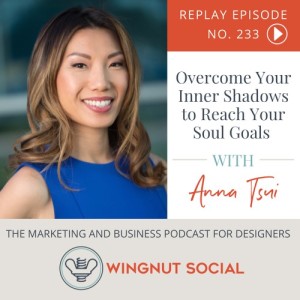
Wednesday Sep 08, 2021
Wednesday Sep 08, 2021
We thought this topic was SO important to take to heart that we’re going to repeat it—just so you don’t forget it. In this special replay, Genius Coach Anna Tsui shares how you can learn to overcome self-sabotage and finally land in your zone of genius. If you’re a business owner struggling with doubt and unable to follow-through on projects, this one's for you.
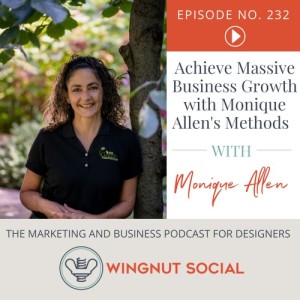
Wednesday Sep 01, 2021
Wednesday Sep 01, 2021
Monique Allen runs a multi-million dollar landscaping design business. She started it with just one employee and now has 22. She makes bank and has zero debt. How did she scale her business? What was the key to her success? Learn more in this episode of Wingnut Social!
Connect with Monique Allen
The Garden Continuum
Get Monique’s Book!
Follow Monique on Instagram
Connect on LinkedIn
Resources & People Mentioned
Let Go to Grow with Doug and Polly White
The Continuum Concept by Jean Liedloff
Overcome Your Limiting Beliefs to Charge What You’re Worth
What You’ll Hear On This Episode of Wingnut Social
[3:11] Mini news sesh: Swipe-ups on Instagram stories
[5:40] Learn how Monique Allen got into landscaping design
[11:01] Why did Monique decide to scale her business?
[21:26] Learn more about what Wingnut Social offers
[23:06] Check out Build Lane for custom furniture!
[24:36] The service packages Monique offers
[28:14] Building a business from one employee to 18
[33:57] One mistake Monique says NOT to make
[35:41] Take the time to imagine what’s possible
[36:52] The What Up Wingnut Round!
[38:54] How to learn more about Monique Allen
[41:00] Blooper Reel!
Why did Monique decide to scale her business?
Monique bought a house, got married, and was about to have a baby. So she wanted a wedge between her personal life and her business. At the time, she had six or seven employees. She wanted to do more of what she excelled at. She decided to gather people around her that had expertise in areas she didn’t. She continued adding hires that lined up to elevate the company. It allowed her to have support and have the impact she desired.
She notes that you can look at your skillset as four quadrants: incompetence, competence, excellence, and genius. She emphasizes that you can’t scale your business if you’re working in your competence. You have to be working in your genius (at the very least, something you excel at). Monique learned to let go of what she was competent at to spend time working in her zone of genius. That’s where your business starts to catapult.
Monique believes the hardest part is to hand off the design work or the client contact. But she has a team that she completely trusts to complete a project—all because she niched down. When you choose a niche, you’ll begin to attract your perfect employee or design partner. Those people are ambassadors of your design strategy.
What is another mindset shift business owners have to make to scale their business? Why did she shift from hourly pricing to packaged services? Listen to hear Monique’s thoughts!
Building a business from one employee to 18
Monique hired her first W-2 employee in 1991. In 2000, she had six employees. She’ll have 22 employees in 2021. At one point, Monique had capped her business at $1.5 million. She was bringing the right clients in and she wanted to hit $2 million, but she realized she needed to shore up her organizational chart and have role clarity in place first. She worked on that for several years. Now she’s in a place where she’s working to scale her business to $2.5 million.
Monique has a corporate team and a production team. Her production team consists of two production leads with direct reports. As the creative director, she makes sure that the strategy around marketing, sales, and onboarding clients is done well. Her tagline is that she is the gardener of people. Her job is to make sure all the people—both clients and employees—are being supported.
How does scaling her business bring her freedom? What was her dream for herself that she extended to her employees? Listen to learn more!
One mistake Monique says NOT to make
Monique says that as a business owner, you have to be clear that there isn’t anyone out there who is going to rescue you. She states: “There isn’t a hire, a client, a job, or software, that is going to rescue you.” Monique believed that if she hired the right person, that everything would fall into place. She was repeatedly disappointed until she realized she needed to embody her vision and direct things the way she wanted them to go. She had to release the death grip she had on the idea that someone would rescue her from the hard work of owning the business.
Check out this week’s episode on Wingnut Social Premium to hear exclusive content about biophilic design and how to partner with landscapers to strengthen your business.
Connect With Darla & Wingnut Social
www.WingnutSocial.com
On Facebook
On Twitter: @WingnutSocial
On Instagram: @WingnutSocial
Darla’s Interior Design Website
Check out the Wingnut Social Media Lab Facebook Group!
1-877-WINGNUT (connect with us for your social media marketing needs)
Wingnut Social Podcast Sponsor: Build Lane
Looking for a great custom furniture option? Check out Build https://buildlane.com/
Subscribe to The Wingnut Social Podcast on iTunes, Google Podcasts, or TuneIn
Audio Production and Show notes byPODCAST FAST TRACKhttps://www.podcastfasttrack.com
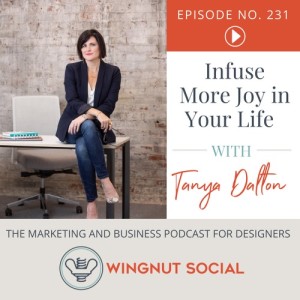
Wednesday Aug 25, 2021
Wednesday Aug 25, 2021
Do you find joy in what you do every day? Or do you struggle to get through each day? Tanya Dalton is a best-selling author, speaker, and nationally recognized productivity expert. In this episode of Wingnut Social, Darla and Tanya talk about some of the concepts in her first book, “The Joy of Missing Out: Live More by Doing Less.” If you’re ready to infuse more joy into your existence, this is the episode for you!
What You’ll Hear On This Episode of Wingnut Social
[0:46] Check out Build Lane custom furniture
[1:28] Learn more about Wingnut Social!
[3:03] Check out Wingnut Premium for a 7-day free trial!
[4:09] Mini news sesh: TikTok is testing a Stories feature
[7:14] Learn more about Tanya Dalton
[9:17] Does your business still give you joy?
[14:39] When do you call it quits and pivot?
[25:30] What “Loving what you do” looks like
[27:28] Learn to live each day on purpose
[32:53] How to get your joy back
[38:07] How to connect with Tanya Dalton
[38:43] The What Up Wingnut Round
[42:23] Blooper Reel!
Connect with Tanya Dalton
Check out Tanya’s website
The Intentional Advantage Podcast
Tanya’s book: The Joy of Missing Out
Connect on LinkedIn
Follow on Instagram
Tanya’s second book, “On Purpose: The Busy Woman’s Guide to an Extraordinary Life of Meaning and Success” is launching October 12th, 2021. Be sure to check it out!
Resources & People Mentioned
Think and Grow Rich by Napoleon Hill
LuAnn Nigara’s Podcast
Does your business still give you joy?
Tanya points out that most people go into business because they’re passionate about it. But then you get bogged down by the behind-the-scenes things that are part of running the business. You lose sight of why you started in the first place. So what do you do? How do you find joy when you’re burned out? Tanya says to take a step back and assess, are you happy? Is this where you want to go? Tanya believes you can inject joy into your business by adding systems and structures that lighten your load. You have the power to choose how your life—and your business—is run.
Many business owners wear a lot of hats—and feel like they have to. You worry that something won’t get done to your standards. It ties into the idea of perfectionism. But guess what? There’s more than one way to do things. You have to relinquish control and delegate. You will get burned by team members and bad hires. You can use those times as learning lessons. It’s part of the journey of entrepreneurship. “That’s part of finding our way to what it is we really want. It’s when we stop doing what everybody else is doing.” You can define success on your own terms. You can define how your business is run. When you take that power and use it, the difference it can make in your life is incredible.
When do you call it quits and pivot?
Tanya points out that moving on and pivoting is part of the evolution for many people. You start something because you think it’s what you want. Tanya’s first business was successful. Her husband quit his job to come work alongside her. The business paid her bills and fed her family. It was checking all of the boxes. But five years into it, she didn’t love the work. She spent a lot of sleepless nights staring at the ceiling, questioning, “Why am I doing this?” If you’re not happy, what’s the point?
That meant taking a step back and assessing her life. She closed her business and took the things she was passionate about and created Inkwell Press Productivity Co. She scaled her business to seven figures in 18 months because she was so passionate about it.
What holds people back? They feel stuck because they’ve put so much time and effort into something that they’ve built. But Tanya emphasizes that you’re never stuck. You can always shift, change, and grow in the direction that you want to grow in. For Tanya, it meant starting over. It was a redefinition of success.
So how do you make a change? Do you take a blind leap of faith? Or engage in purposeful planning? Listen to hear what Tanya would do.
How to live each day on purpose
People get bogged down by the idea of purpose. But Tanya believes that having a purpose is simply living bigger than today. It’s seeing who you want to be in the future and working toward that. It’s rising up to be the best version of you. You have to understand where you want to go and then work backward to map it out. What is possible in 3–5 years? What’s practical to get done in a year? You break it down into what you can prioritize in 3–6 months. Then you take your goals, your daily actions, and tie them to that destination you want to get to. When you do fewer things tied to your vision you find that you’re happier. Five small steps toward your purpose bring you closer to where you want to go.
To learn more about Tanya’s processes, methods, and her “MTO Method for Setting Goals” head on over to Wingnut Social Premium!
Connect With Darla & Wingnut Social
www.WingnutSocial.com
On Facebook
On Twitter: @WingnutSocial
On Instagram: @WingnutSocial
Darla’s Interior Design Website
Check out the Wingnut Social Media Lab Facebook Group!
1-877-WINGNUT (connect with us for your social media marketing needs)
Wingnut Social Podcast Sponsor: Desi Creswell
Ready to stop being overwhelmed? Check out Desi Creswell’s new “Out of Overwhelm” coaching group
Desi Creswell’s Daily Planner
Wingnut Social Podcast Sponsor: Build Lane
Looking for a great custom furniture option? Check out Build https://buildlane.com/
Subscribe to The Wingnut Social Podcast on iTunes, Google Podcasts, or TuneIn
Audio Production and Show notes byPODCAST FAST TRACKhttps://www.podcastfasttrack.com
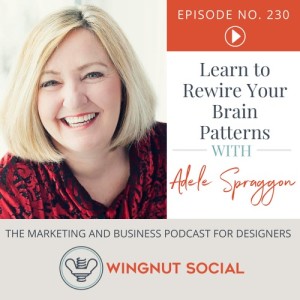
Wednesday Aug 18, 2021
Wednesday Aug 18, 2021
Do you struggle to reach goals? No matter how many vision boards you create or how you shift your mindset, you’re always falling short? Maybe you’re doing things all wrong. In this episode of Wingnut Social, Adele Spraggon shares how to recognize brain patterns and what you can do to deconstruct and rewire them. Her process can transform your brain and help you achieve what you never thought possible!
Adele Spraggon is an award-winning author, thought-leader, international speaker, and trainer. She was awarded the 2020 Women of Inspiration Award and was recognized as a top behavioral expert in 2021. Her book, “Shift: 4 Steps to Personal Empowerment,” has won three awards and is sweeping the globe, transforming how people are setting and achieving their goals.
What You’ll Hear On This Episode of Wingnut Social
[3:28] Mini news sesh: How the Instagram Reels algorithm works
[8:40] Learn more about brain pattern expert Adele Spraggon
[14:46] What a brain pattern is and how it impacts you
[21:18] Does the brain develop patterns based on past experiences?
[25:24] Check out Build Lane at https://buildlane.com/
[26:54] The steps to take to change your brain patterns
[33:12] Why shifting to “positive thinking” isn’t the answer
[38:56] We continue the conversation on Wingnut Premium!
[39:13] It’s time for the What up Wingnut round
[40:19] Rerouting neural pathways with psychedelics
[44:00] Blooper Reel!
Connect with Adele Spraggon
Check out Adele’s website
Get a FREE autographed copy of Adele’s book (just pay shipping)
Adele’s book: Shift: 4 Steps to Personal Empowerment
Resources & People Mentioned
The Master and His Emissary by Iain McGilchrist
What made Adele quit her first three businesses?
After 15 years in the personal development industry, Adele realized that traditional mindset methods didn’t work. She did all of the right things, yet started and quit three different businesses. So she decided to learn more about the human brain. Adele went back to school and got a master’s degree in humanities. When she learned how the brain works, she realized where the disconnect was.
We think that what our brain “sees” is perfectly aligned with the external situation. But your brain creates its reality from the external situation.She had to learn how to re-pattern the part of her brain that led her to quit repeatedly. She developed a new set of operating instructions. Everything changed.
In Adele’s case, she discovered that her brain pattern was people-pleasing. So anytime she thought she upset someone, she ran in the opposite direction. But how do you recognize your brain pattern? Start by learning what a brain pattern is.
What is a brain pattern?
A brain pattern is a combination of three factors: a physical sensation, an emotion, and a thought. When these three things come together, they result in a particular action, behavior, or belief. The brain is like an iceberg. Above the water is everything you do, think, or say is above the water. Under the water is the brain pattern that gives rise to your actions.
When Adele started a business, her initial brain pattern was one of excitement. But her brain perceived the world as being displeased with her idea. That triggered another pattern, one of discomfort, anxiousness, and panic. Her action was to quit. Her brain was warring over two different patterns. They were neural pathways in her brain that she needed to identify.
Does your brain develop patterns based on past experiences?
Adele notes that human beings are not born with instincts like many animals are. From the moment a baby enters the world, they must piece together brain patterns to take action. Every situation causes a reaction in the brain which causes it to create a neural pathway (i.e. a brain pattern). Once that pathway is created, your brain prefers to use that channel. Until you recognize and remove that brain pattern, your brain will default to it.
But the beautiful thing is that brains are plastic, they’re malleable. Adele notes that in the last 20–25 years, there has been an explosion of research in the field of neuroscience. We used to think that the brain was hardwired when we reached adulthood. The truth is that you can quickly re-pattern the brain because it is designed to keep rewiring itself—you just need to know how to work it.
The steps to take to change your brain patterns
How do you give your brain new operating instructions? Adele advises that if something is preventing you from moving forward, you need to ask “What am I feeling? Where am I feeling that? What is my one thought?” In Adele’s case, she felt anxiety in her stomach. Her thought was “I have to quit.” That is a pattern. Her next step is to own it as a pattern. She just had to acknowledge, “I created a pattern in my brain that is now feeling and doing this.” Then you must deconstruct the pattern and replace it with something else. But you can only create the new pattern once you remove the old one.
So what does the process look like? Why is positive thinking more harmful than helpful? Listen to the whole episode to learn more about rewiring your brain’s patterns. And to learn more about recreating your brain patterns by listening to your right brain, check out the extended interview at Wingnut Premium!
Connect With Darla & Wingnut Social
www.WingnutSocial.com
On Facebook
On Twitter: @WingnutSocial
On Instagram: @WingnutSocial
Darla’s Interior Design Website
Check out the Wingnut Social Media Lab Facebook Group!
1-877-WINGNUT (connect with us for your social media marketing needs)
Wingnut Social Podcast Sponsor: Build Lane
Looking for a great custom furniture option? Check out Build Lane https://buildlane.com/
Subscribe to The Wingnut Social Podcast on iTunes, Google Podcasts, or TuneIn
Audio Production and Show notes byPODCAST FAST TRACKhttps://www.podcastfasttrack.com
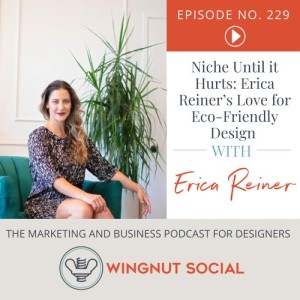
Wednesday Aug 11, 2021
Wednesday Aug 11, 2021
After a career in environmental science Erica Reiner decided to marry her two loves—environmental science and design—and became an eco-friendly designer. Erica’s passion is to help people transform their space, health, and the planet. She does full-service and eDesign for both residential and commercial clients. She also has her own podcast called “Green by Design.” Listen to this episode of Wingnut Social to hear about her journey to niche until it hurts.
What You’ll Hear On This Episode of Wingnut Social
[1:16] Don’t forget to check out Wingnut Social!
[4:45] Mini News Sesh: Instagram’s newest feature
[7:24] All about eco-friendly designer Erica Reiner
[13:20] Wat eco-friendly design means to Erica
[17:09] Erica’s strategies for marketing
[20:50] Check out Build Lane for custom furniture!
[23:02] Don’t be afraid to niche until it hurts
[28:48] Did COVID ramp up the desire for eco-friendly design?
[30:48] How can the design industry become greener?
[34:10] The What Up Wingnut! Round
[39:34] Blooper Reel!
Connect with Erica Reiner
Eco Method Interiors
Connect on LinkedIn
Follow on Instagram
The Green by Design podcast
You Are a Badass at Making Money by Jen Sincero
Getting Things Done by David Allen
Resources & People Mentioned
Wingnut Social Premium Mastermind: 1pm August 25th
Episode #122 with Mike Peterson and Michelle Castagna
Visionary Design Marketing
What eco-friendly design means to Erica
Erica notes that eco-friendly is an umbrella term that can include human health and a deep look at chemical exposures and toxicity. It can also include the impact you’re having on the earth itself. It’s why Erica incorporates eco-friendly design into her entire method. She weaves in eco-friendly things that make sense in every project. Her goal was to make sustainability and eco-friendly design as accessible as possible.
Each client Erica works with is kept informed of what she’s doing with a customized “green guide” for their project. While she is careful to spend money on what’s important to the client, they are all aware that she incorporates eco-friendly sourcing. She works with vendors who strive to create sustainable pieces.
So is Erica’s design style considered Vegan? Listen to hear why Erica believes she can’t fall into that category. HINT: it’s about sustainability...
Don’t be afraid to niche until it hurts
Erica designs so many different types of aesthetics but it’s always classified within eco-friendly design. After Erica shifted to full-time design in 2018, she felt like she failed miserably. But when she stopped offering eco-friendly design as a separate service and incorporated it into her entire process, everything changed. The efforts she made with SEO started to pay off.
Darla never recommends that you do something you don’t love. If you’re passionate about different aesthetics, do it. Erica still has the thread of eco-friendly design woven in. Erica believes that if you’re afraid to niche, you’re embracing a scarcity mindset. If you niche into something you’re passionate about it will be enough to sustain you.
Erica also chose a niche because she desires to teach other home pros and designers about the importance of eco-friendly design. She launched a podcast that shares tips and tricks, how-tos, what to be aware of—anything green. It’s another piece of the marketing puzzle to become an authority in the eco-friendly industry. Erica emphasizes that environmental problems and human health problems are one and the same. There is so much improvement to come in the movement toward greener and cleaner.
Want to learn Erica’s client satisfaction process to not only end a project with happy clients but also get referrals? Head on over to Wingnut Premium!
Connect With Darla & Wingnut Social
www.WingnutSocial.com
On Facebook
On Twitter: @WingnutSocial
On Instagram: @WingnutSocial
Darla’s Interior Design Website
Check out the Wingnut Social Media Lab Facebook Group!
1-877-WINGNUT (connect with us for your social media marketing needs)
Wingnut Social Podcast Sponsor: Build Lane
Looking for a great custom furniture option? Check out Build https://buildlane.com/
Subscribe to The Wingnut Social Podcast on iTunes, Google Podcasts, or TuneIn
Audio Production and Show notes byPODCAST FAST TRACKhttps://www.podcastfasttrack.com
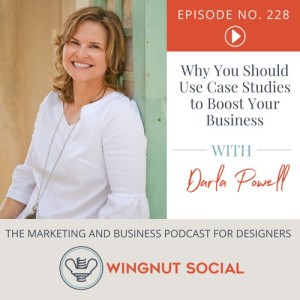
Wednesday Aug 04, 2021
Wednesday Aug 04, 2021
How can you incorporate case studies for your interior design business on your website? Why should you? Case studies are a testimonial with black-and-white hard numbers of what a business has accomplished for a client. In this episode of the Wingnut Social podcast, Darla is going to talk about two of her case studies—and why they’re so important.
What You’ll Hear On This Episode of Wingnut Social
[0:56] Real-life case studies from current clients
[2:40] Mini news sesh: Instagram security tips
[9:00] Case Study #1: Plush Couture Interiors
[13:27] Case Study #2: MOOD | Design + Build
[14:46] Learn about designing custom furniture with Build Lane!
[22:10] Join Wingnut Premium to learn more about creating a strategy
[24:59] The wackiest Wingnut blooper reel!
Resources & People Mentioned
Case Study: Plush Couture Interiors
Plus Couture Interiors
Case Study: MOOD | Design + Build
MOOD | Design + Build
Case Study #1: Plush Couture Interiors
When Teresa Gonzalez contacted Wingnut Social, she was relocating from LA to Portland, Oregon. Her business needed to establish a presence in a completely new demographic. She needed to adapt her brand voice to attract clients in Portland. So Wingnut Social created a strategy that focused on branding using consistency in voice, messaging, and imagery. They also made sure she was known for luxury design and as a lifestyle influencer.
How did Wingnut make it happen? By interspersing Teresa’s feed with both luxury and inspirational content, while including images of Teresa. They also made sure to write posts in Teresa’s voice so it reflected her approachable personality. They wrote posts to engage her audience and start conversations. Followers would also learn about what Plush Couture could do for them. They also researched hashtags to use based on analytics and customized them to each post to reach more Instagram users who weren’t yet followers.
What were the results? In the first 2–3 months her account saw an increase of over 12,000% in impressions, over 7,800% increase in engagements (likes, comments, shares, saves), and a 900% increase in followers over two months. Her closest competitor only saw an increase in followers of 15.2% during the same time. Even better? Some of her posts have gone viral.
When you’re starting a successful Instagram campaign, you want to make sure that brand awareness is the main thing you’re working on. What can you do to engage your followers? Listen to hear Darla share some tips!
Case Study #2: MOOD | Design + Build
Candy Scott came to Wingnut Social for help building brand awareness for her design firm. She wanted to be known, heard, and seen in the industry and build brand awareness, beginning locally in Chicago. Differentiation from competitors is key to positioning. Where do you fall? What do you offer to an ideal client? Candy differentiates herself because of her expertise in project management for large design-build jobs.
To attract clients on Instagram, Wingnut created a strategic content mix of interior design and interior architecture—to emphasize the build part of her business—as well as lifestyle photos of her team. They used highly engaging questions in captions to provoke replies and comments. It may seem basic but people often neglect drawing readers into conversations.
Candy’s second goal was to show up in Google searches for build design firms in Chicago. So Wingnut optimized her website to appear in the top-10 of search results, increasing brand visibility online. They used keyword research to optimize her website for local Chicago-based searches. They continued to build heavily optimized blog posts so they’d appear in Google searches. Even better? Blurbs, testimonials, quotes, etc. from blog posts can be used on social media.
What were the results? MOOD Design + Build’s impressions on Instagram increased 20,400%. Their engagement increased 48,300% and their followers more than doubled. Wingnut Social increased their search position on Google by an average of 27 spots leading to an increase in organic search traffic of 27%—in the first three months.
If you post case studies for your clients on your website—and potentially on your social media, depending on your strategy—it can boost interest in your services. Learn all about it in this episode of Wingnut Social!
Join Wingnut Premium to learn more about creating a strategy from scratch. But if you want help with marketing, let us know!
Connect With Darla & Wingnut Social
www.WingnutSocial.com
On Facebook
On Twitter: @WingnutSocial
On Instagram: @WingnutSocial
Darla’s Interior Design Website
Check out the Wingnut Social Media Lab Facebook Group!
1-877-WINGNUT (connect with us for your social media marketing needs)
Wingnut Social Podcast Sponsor: Desi Creswell
Ready to stop being overwhelmed? Check out Desi Creswell’s new “Out of Overwhelm” coaching group
Desi Creswell’s Daily Planner
Wingnut Social Podcast Sponsor: Build Lane
Looking for a great custom furniture option? Check out Build Lane
Subscribe to The Wingnut Social Podcast on iTunes, Google Podcasts, or TuneIn
Audio Production and Show notes byPODCAST FAST TRACKhttps://www.podcastfasttrack.com
![Overcome Your Limiting Beliefs to Charge What You’re Worth [Sarah Schneider] - Episode 227](https://pbcdn1.podbean.com/imglogo/ep-logo/pbblog3132020/WSPodcast_LI_PodbeanGraphic_episode227SarahSchneider_300x300.png)
Wednesday Jul 28, 2021
Wednesday Jul 28, 2021
If you are a regular listener, you’ve likely heard the phrase “Charge what you’re worth.” But how do you know what you’re worth? How much work does it take to get to a point where you can charge what you want? Is it all it’s cracked up to be? In this episode of Wingnut Social, Executive Coach Sarah Schneider breaks down how to figure out what “Charging what you’re worth” actually means. Don’t miss it!
What You’ll Hear On This Episode of Wingnut Social
[0:49] Learn more about episode sponsor: Build Lane
[1:21] Wingnut Social is the real deal
[3:18] Mini news sesh: New Instagram sticker feature
[6:21] Learn all about Sarah Schneider
[10:38] Why designers struggle with charging what they’re worth
[15:56] How to work through the psychological struggle
[24:02] How do you determine what you’re worth
[32:47] The What Up Wingnut! Round
[34:41] How to connect with Sarah Schneider
[35:37] Learn more about the Wingnut Premium program
[38:20] Check out this week’s blooper reel!
Connect with Sarah Schneider
Sarah’s Website
Connect on LinkedIn
Follow on Instagram
Resources & People Mentioned
The Gifts of Imperfection by Brene Brown
How to overcome the psychological struggle to charge what you’re worth
Sarah knows that designers struggle with comparison and self-criticism. They think they need more experience or that people won’t pay their rates. She emphasizes that you have to take an honest look at your background, skillset, and the results that you provide people. Make it about what you deliver and the impact you have. If you’re a high-end designer you’ll charge differently than someone who declutters and organizes spaces. You also have to take into account what you need to make based on your overhead.
People get lost in, “Who am I to charge that?” From a psychological and self-worth standpoint, how do you overcome this limiting belief? Sarah believes that you’re never as new at something as you think you are. A designer has likely used their skillsets in other areas of their life, right? Now you’re simply executing it differently. Sarah challenges people to always take a beginner’s viewpoint and look at things with fresh eyes. But “new” at something doesn’t mean inexperienced. Don’t take your knowledge for granted.
Focus on what you bring to the table
Self-doubt is a dream and performance crusher. It's the beginning of the end of your goals. It’s so easy to discount what you know because—let’s be honest—it comes naturally. Sarah coaches people to take inventory of what they bring to the table. If you’re your own worst critic, this can be easier to do with someone who knows you well (someone who champions you or a client that loves you).
What have you done since you were a kid?
What was your formal or informal education?
What roles have you had throughout your life and career?
What type of advice do people ask you for?
Brainstorm this with someone and write it down—even if you think it’s an obvious or trivial skill. When you’re in a place of self-criticism, you can look back at the list and see what you bring to the table. It’s easier to be kind to yourself when you have collected evidence in your favor.
How do you determine what you’re worth
Sarah works with a lot of entrepreneurs. People are often coached to charge a certain amount if they want to appear credible. Sarah recommends that you find a middle ground somewhere between what you’re comfortable with and what the “experts” say you should be charging. It needs to be an integration of a number that stretches you that you’re willing to say out loud—without throwing up.
When Darla started charging what she was worth (to make a profit, stay in business, and give clients the service she’s renowned for), clients started knocking down the door. Darla has a waiting list and she’s never been busier. Darla has found in some cases that doubling your hourly rate can make people pick up the phone. Why does that happen? Listen to the whole episode to hear Sarah share her thoughts.
To hear more from Sarah about the breaking away from the comparison game, head on over to Wingnut Premium for an exclusive episode!
Connect With Darla & Wingnut Social
www.WingnutSocial.com
On Facebook
On Twitter: @WingnutSocial
On Instagram: @WingnutSocial
Darla’s Interior Design Website
Check out the Wingnut Social Media Lab Facebook Group!
1-877-WINGNUT (connect with us for your social media marketing needs)
Wingnut Social Podcast Sponsor: Desi Creswell
Ready to stop being overwhelmed? Check out Desi Creswell’s new “Out of Overwhelm” coaching group
Desi Creswell’s Daily Planner
Wingnut Social Podcast Sponsor: Build Lane
Looking for a great custom furniture option? Check out Build https://buildlane.com/
Subscribe to The Wingnut Social Podcast on iTunes, Google Podcasts, or TuneIn
Audio Production and Show notes byPODCAST FAST TRACKhttps://www.podcastfasttrack.com
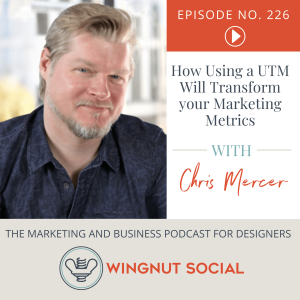
Wednesday Jul 21, 2021
Wednesday Jul 21, 2021
How do you really know where your leads are coming from? How do you know if a campaign you’re running is successful? In this episode of WingnutSocial, the founder of Measurement Marketing—Chris Mercer—shares a genius way to track your leads and manage your campaigns with UTMs (Urchin Tracking Modules). Even better, it can save you a whole lotta moolah. Don’t miss it!
What You’ll Hear On This Episode of Wingnut Social
[1:47] For more info on this subject head over to Wingnut Premium!
[2:13] Mini News Sesh: Instagram changing its model
[6:12] Learn more about Chris Mercer’s expertise
[9:55] What in the world is a UTM?
[12:42] How to set up a design campaign with UTMs
[18:25] How to understand the UTM terminology
[23:07] Learn more about our sponsor Build Lane
[25:35] Email marketing using UTMs
[34:24] Learn to be good enough to get going
[35:32] The What Up Wingnut Round!
[38:32] Where to learn more about Measurement Marketing
[43:39] Blooper Reel!
Connect with Chris Mercer
https://measurementmarketing.io/
Measurement Market FREE Toolbox Kit (Be sure to look at the UTM in the link on the webpage!)
Connect on LinkedIn
Resources & People Mentioned
Adam Mosseri’s Announcement on Instagram
Influence by Robert Cialdini (The updated edition)
ActiveCampaign
What in the world is a UTM?
An Urchin Tracking Module (Thank God someone shortened it to UTM) is a parameter. When you go into your email and go to click on a link, look at the link. It will often end with something like “UTM_Source=” AKA a parameter. They identify themselves with platforms like Google analytics. So if you click on a link in an email, the UTM will tell Google Analytics that you came to someone’s site from an email. It will tell them the email you clicked on and even the subject line. Social media is a place you can get really busy and it’s great to know if your activity leads to results. That’s why a UTM is important.
You might go into Google analytics and see something like Facebook.com/referral or Pitnerest.com/referral. You know those platforms caused that person to come to your site. With UTMs you can take it a step further and know exactly where the referral came from (such as a paid ad or pin that they clicked on). You get better at identifying where your traffic is coming from.
How to set up a campaign with UTMs
Chris points out that when you share a photo or story you usually have a call to action where someone can click on a link to learn more. When you create that CTA, you can add the UTM parameters. The goal is to identify the who, what, and the why. Who is sending you traffic? What type is being sent? What was the purpose of the traffic?
If Chris just enters his homepage, Google will tell him they came from Instagram to the site but it doesn’t tell him much else. But he could add the parameters “UTM_Source=Instagram” to identify the source of the traffic (i.e. the “brand name” of the traffic source). He could use “UTM_Medium=Social” to know it’s stuff that he’s sharing for social engagement (i.e. the type of traffic). A parameter of “UTM_Campaign=Academy” can tell him the purpose of the traffic (to join his training academy).
A UTM allows you to identify where to spend your time, including the platform and type of posts. You can really hone in and employ the most effective marketing for your business. Using UTMs should NOT be optional for you.
Listen to the whole episode to hear Chris explain why you should use UTMs for emails—and how to do it! And to learn how to use UTMs for different mediums, head on over to Wingnut Premium for an extended interview.
Connect With Darla & Wingnut Social
www.WingnutSocial.com
On Facebook
On Twitter: @WingnutSocial
On Instagram: @WingnutSocial
Darla’s Interior Design Website
Check out the Wingnut Social Media Lab Facebook Group!
1-877-WINGNUT (connect with us for your social media marketing needs)
Wingnut Social Podcast Sponsor: Desi Creswell
Ready to stop being overwhelmed? Check out Desi Creswell’s new “Out of Overwhelm” coaching group
Desi Creswell’s Daily Planner
Wingnut Social Podcast Sponsor: Build Lane
Looking for a great custom furniture option? Check out Build https://buildlane.com/
Subscribe to The Wingnut Social Podcast on iTunes, Google Podcasts, or TuneIn
Audio Production and Show notes byPODCAST FAST TRACKhttps://www.podcastfasttrack.com
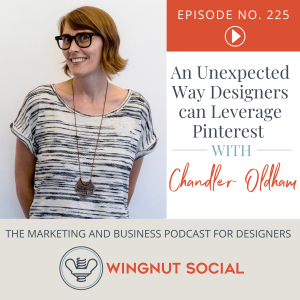
Wednesday Jul 14, 2021
Wednesday Jul 14, 2021
We’ve talked about how designers can leverage Pinterest with their social media marketing strategy. But is there another way to use Pinterest, both internally and externally? Chandler Oldham certainly believes so. In this episode of Wingnut Social, she shares the unique way her firm—DXA Studio—uses Pinterest. Don’t miss it!
What You’ll Hear On This Episode of Wingnut Social
[0:43] Check out Desi Creswell’s coaching group!
[1:05] Head on over to Build Lane for customer furniture
[2:49] Mini News Sesh: Live audio groups on Facebook
[6:30] Learn more about Chandler Oldham
[11:16] How COVID changed the landscape
[13:26] How Chandler is using Pinterest with clients
[19:07] How Pinterest helps with the creative process
[26:04] How to combine Pinterest and other resources for inspiration
[29:40] Pinterest applies to hospitality and commercial design as well
[32:00] How Chandler sources products and vendors on Pinterest
[38:36] The What Up Wingnut Round
[41:12] How to connect with Chandler Oldham
[46:12] Blooper Reel!
Connect with Chandler Oldham
Connect on LinkedIn
Save her pins on Pinterest
Follow on Twitter
Resources & People Mentioned
DXA Studio
Pinterest Save Button
Episode #218 with Kate Ahl
Watership Down by Richard Adams
DXA Ten Years
Pinterest for collaboration
As a way to collaborate on ideas, Chandler’s team likes to create a Pinterest board for projects so people can save things in it. It’s also great when you have clients who want to be more hands-on, which developers seem to be moving toward. During COVID, it was also one of the easiest ways to communicate and not waste time going in the wrong direction.
Chandler points out that their use of Pinterest is heavy-handed during the concept period when they’re doing most of the designing. But Chandler loves to use it throughout the entire process. You can send a detailed image to a client or a contractor and it conveys so much more than trying to explain with words. Plus, it saves you from having to make a sketch.
The only downside of Pinterest is that you can go down the rabbit hole trying to find something. Their algorithm tends to send you the same images repeatedly and you have to know how to get to what you’re searching for.
Tips and tricks to best utilize Pinterest
When you find a furniture maker or designer that you like, Chandler emphasizes that you should spend time on their websites. Use the Pinterest plugin so that you can save images from their site. That way, you’re constantly saving things to Pinterest for yourself. It gives you a new place to get images and it changes what the algorithm gives you versus solely searching inside Pinterest. She makes sure the original owners of the image get the credit for the image. Lastly, Chandler recommends that you create as many boards as you can for yourself and save, save, save photos. You’ll be upset if you didn't save an image and try to recall it later, only to realize you can’t find it.
How Pinterest helps with the creative process
Chandler uses Pinterest all the time because she’s always thinking one project ahead. She wants to always inspire herself and stay on top of the next best thing. Pinterest helps her firm stay on top of what’s trending and what’s happening in the marketplace. As a designer, Chandler loves any site that allows her to peruse images. Pinterest also makes the world smaller. Since the world couldn’t travel, every resource was posting new things on Facebook, Pinterest, Instagram, etc. Social media allows the whole world to open up to you and you can see things from a different perspective. How does Chandler use Pinterest to source vendors and tradesmen? Listen to learn more!
Want even more great content? Head on over to Wingnut Premium!
Connect With Darla & Wingnut Social
www.WingnutSocial.com
On Facebook
On Twitter: @WingnutSocial
On Instagram: @WingnutSocial
Darla’s Interior Design Website
Check out the Wingnut Social Media Lab Facebook Group!
1-877-WINGNUT (connect with us for your social media marketing needs)
Wingnut Social Podcast Sponsor: Desi Creswell
Ready to stop being overwhelmed? Check out Desi Creswell’s new “Out of Overwhelm” coaching group
Desi Creswell’s Daily Planner
Wingnut Social Podcast Sponsor: Build Lane
Looking for a great custom furniture option? Check out Build https://buildlane.com/
Subscribe to The Wingnut Social Podcast on iTunes, Google Podcasts, or TuneIn
Audio Production and Show notes byPODCAST FAST TRACKhttps://www.podcastfasttrack.com
![Interior Designers: You NEED to Network with Realtors [per Eric Reeves] - Episode 224](https://pbcdn1.podbean.com/imglogo/ep-logo/pbblog3132020/WSPodcast_LI_PodbeanGraphic_episode_guestname_2__yqvi9w_300x300.png)
Wednesday Jul 07, 2021
Wednesday Jul 07, 2021
Why do interior designers and home stagers need professional relationships with realtors? How can this relationship further your business and put dollars in your pocket? How do you build those relationships in the first place? Darla and Eric Reeves set out to answer these questions in this episode of Wingnut Social!
What You’ll Hear On This Episode of Wingnut Social
[0:49] Get your custom furniture through Build Lane!
[1:21] Desi Creswell’s new “Out of Overwhelm” group
[3:16] Mini news sesh: Rumored Facebook news
[5:46] Check out Wingnut Social Premium!
[7:40] Learn more about Eric Reeves
[11:00] How real estate + interior design mesh
[13:45] Why interior designers should network with realtors
[23:05] How Eric built his reputation in his community
[25:58] How home stagers can sell their value to realtors
[28:00] Eric’s thoughts about digital staging
[33:16] The “What Up Wingnut” Round!
[35:43] Darla’s take: Networking tips + tricks
[38:32] Blooper Reel!
Connect with Eric Reeves
RYS Interior Consulting
Connect on LinkedIn
Follow on Instagram
Resources & People Mentioned
Book: Tuesdays with Morrie by Mitch Albom
WS Episode #135 with Sandra Funk: Interior Design Consultation
How real estate + interior design mesh
Eric is one of the few that can stage a home, sell it, and remodel it. Because of his degree in interior design, he can help buyers visualize the potential of the space when he’s showing it. He can help people see how to make a home of their own. He can also advise buyers of resale value and help them determine changes to make that stay within the budget of the neighborhood. When Eric started his business, it was geared toward home staging because there was nothing in his area. As a realtor, seeing how homes were presented, he knew his market needed the service.
Why interior designers should network with realtors
Eric points out that realtors are a great resource to home buyers and sellers. New home buyers might need an electrician, plumber, contractor, etc. Most of the homes in Eric’s area are resales—not new construction—so remodeling is always a consideration. Most people who own a home at some point will need to sell or buy. The homeowner will likely ask you for interior design recommendations. That’s why a symbiotic relationship between designers and realtors is imperative.
What benefit does the realtor get? When you’re a great resource for your clients, it keeps you top of mind. When they go to buy or sell, you’re the person that comes to mind. Eric’s market is a lot of second homes and vacation homes. They tend to be empty or furnished with pieces that are outdated and old. They often need a designer’s touch to help them move.
How home stagers can sell their value to realtors
Eric recommends that home stagers and interior designers need to build a good relationship with realtors—and know your numbers. You need to be familiar with the inventory on the market. You need to understand if the market is hot or barely moving. It’s all about perceived value. 95% of people start their home searches online. So you need to communicate to your client the value of a well-staged home.
You also need a professional online presence (website and social media). You need a packet of information that’s exceptional that you can provide outlining the services you offer. You also need to be able to communicate the value of your work (and how it can lead to more money for the homeowner and realtor).
Eric believes there’s a place for both normal and digital staging. If someone needs a quick turnaround at a low price point, digital staging may be the way to go. But Eric points out if he’s showing a home with staged photos online but walks into an empty house, it’s a letdown. People don’t have the vision to see what could be. But if you can learn to do both, do it. You don’t want to be the Blockbuster of the interior design industry.
Listen to the whole episode for some networking tips + tricks from Darla!
Connect With Darla & Wingnut Social
www.WingnutSocial.com
On Facebook
On Twitter: @WingnutSocial
On Instagram: @WingnutSocial
Darla’s Interior Design Website
Check out the Wingnut Social Media Lab Facebook Group!
1-877-WINGNUT (connect with us for your social media marketing needs)
Wingnut Social Podcast Sponsor: Desi Creswell
Ready to stop being overwhelmed? Check out Desi Creswell’s new “Out of Overwhelm” coaching group
Desi Creswell’s Daily Planner
Desi has a six-month customized coaching experience
Wingnut Social Podcast Sponsor: Build Lane
Looking for a great custom furniture option? Check out Build https://buildlane.com/
Subscribe to The Wingnut Social Podcast on iTunes, Google Podcasts, or TuneIn
Audio Production and Show notes byPODCAST FAST TRACKhttps://www.podcastfasttrack.com
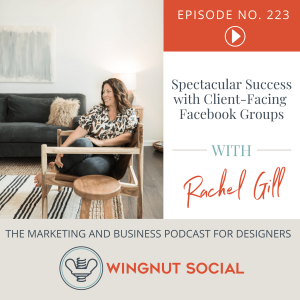
Wednesday Jun 30, 2021
Wednesday Jun 30, 2021
Rachel Gill has been in business for a little over a year. At the beginning of 2021, she decided to create a client-facing Facebook group for homeowners or renters to bring as a client outreach tactic. She went to a local Mom’s Facebook group and shared what she was thinking about doing and asked if anyone would be interested. She got a huge response. The group started at around 400 and is up to almost 700. How does sharing value in this group lead to new clients? Is she giving too much away? Listen to this episode of Wingnut Social to learn more!
What You’ll Hear On This Episode of Wingnut Social
[2:42] Mini News Sesh: Monetizing Instagram
[6:10] Rachel’s expertise in Facebook groups
[8:01] How a Facebook group serves clients
[12:53] The types of clients Rachel gets
[20:11] How other designers feel about Rachel’s tactics
[23:30] What does Rachel do for a call to action?
[25:38] Where do you get started?
[30:00] The What up Wingnut round!
[31:20] How to connect with Rachel Gill
[34:31] Go check out Wingnut Premium!
[35:58] Wingnut Social blooper reel!
Connect with Rachel Gill
Facebook Group: Homeschool | Design + Renovation with Rachel Gill: https://www.facebook.com/groups/218450516351263/
Follow Rachel on Instagram: https://www.instagram.com/rachelgilldesign/
Rachel’s Design Website: https://www.rachelgilldesign.co/
Resources & People Mentioned
Use code “WINGNUT250” for a $250 discount at https://buildlane.com/!
Wingnut Social episode #120 with Natasa Jones: https://wingnutsocial.com/podcast/facebook-community-groups-an-innovative-way-to-market-your-interior-design-business-with-natasa-jones-episode-120/
Profit First by Mike Michalowicz: https://www.amazon.com/Profit-First-Transform-Cash-Eating-Money-Making-ebook/dp/B01HCGYTH4
Colleen Primm: https://www.colleenprimmdesign.com/
Studio McGee: https://studio-mcgee.com/
How a Facebook group serves clients
Rachel emphasizes that the know, like, and trust factor is really important for your business and your brand. Rachel’s goal was to become an expert in her area for home design and renovation. So she geared her Facebook group toward answering questions, educating, and becoming that go-to expert. Sure, the majority of the people in her group are likely DIYers but a large handful has hired her for design projects. People will go to the person sharing free—valuable—advice.
But what kind of clients can Rachel source from a Facebook group? She notes that she gets anything from a one-off consult to a full first-floor renovation—all from the group. People will see her on Facebook, like her style and posts, and reach out to have her come look at their projects.
Rachel’s theory is that even if you “give away” pieces or colors from a room you’ve designed, people do not have the same creative mind as you. It will never turn out the same way as your final design.
How to start your own client-facing Facebook group
Rachel 100% recommends that you engage in your local groups first. If you dive into a group where you’ve had no interaction and ask them to join another group, it won’t go well. But if you engage others and ask them to help you build something just for them—and they feel they’re helping direct the topics and getting questions answered—you'll have immediate buy-in. To do this, Rachel asked how members would like the information presented (blog post, photos, videos, etc.) and the majority wanted blog posts.
Rachel reached out to mom’s groups for the county she lives in, the neighboring county, and the largest town near her. Why mom groups? Because it’s where people go to get advice. They ask for contractor, painter, and home improvement recommendations all the time. She saw that people were asking and knew her Facebook group would appeal to them. But how does she get clients from a group?
Rachel will randomly intersperse a design process type of post, share working through a project, etc. She’ll then add a call to action like “If you’d like to design the bathroom of your dreams, connect with me to set up a FREE discovery call.” She’ll often get a DM a day or two later. 85–90% of her clients have come from this group.
Looking for the deets on specific content that Rachel shares that gets her the most traction? Head on over to Wingnut Premium!
Connect With Darla & Wingnut Social
www.WingnutSocial.com
On Facebook
On Twitter: @WingnutSocial
On Instagram: @WingnutSocial
Darla’s Interior Design Website
Check out the Wingnut Social Media Lab Facebook Group!
1-877-WINGNUT (connect with us for your social media marketing needs)
Wingnut Social Podcast Sponsor: Desi Creswell
Ready to stop being overwhelmed? Check out Desi Creswell’s new “Out of Overwhelm” coaching group
Desi Creswell’s Daily Planner
Wingnut Social Podcast Sponsor: Build Lane
Looking for a great custom furniture option? Check out Build https://buildlane.com/
Subscribe to The Wingnut Social Podcast on iTunes, Google Podcasts, or TuneIn
Audio Production and Show notes byPODCAST FAST TRACKhttps://www.podcastfasttrack.com
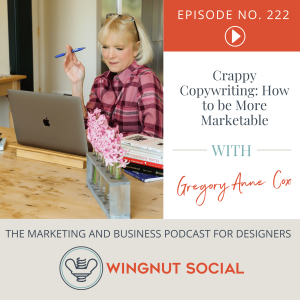
Wednesday Jun 23, 2021
Wednesday Jun 23, 2021
Are you struggling to market yourself? Does the copywriting on your website leave something to be desired? Are you ready for a career change but struggling with self-doubt? In this episode of Wingnut Social, you’ll get a special two-part episode with Gregory Anne Cox—both coach and copywriter—covering how to be more marketable and how to overcome self-doubt. Don’t miss it!
What You’ll Hear On This Episode of Wingnut Social
[0:45] check out Desi Creswell's “Out of Overwhelm” program
[2:30] Learn more about Gregory Anne Cox
[4:40] How to crush your inner doubt
[9:40] Crappy copywriting: How to Be More Marketable
[16:25] Turning crappy copy around (no names named)
[24:13] Gregory’s last bit of copywriting wisdom
[25:11] The What Up Wingnut! Round
[28:42] Check out Wingnut Premium
[30:19] Blooper reel!
Connect with Gregory Anne Cox
Rebellious Wellness Over 50 podcast: https://rebelliouswellnessover50.com/rwo50-podcast/
Gregory’s copywriting business: https://bemoremarketable.com/
Connect on LinkedIn: linkedin.com/in/gregoryanne/
Resources & People Mentioned
“It's Not Too Late, You Actually Just Started” video: https://www.youtube.com/watch?v=Z_8jSIRlZ_g
The Overstory by Richard Powers: https://www.amazon.com/Overstory-Novel-Richard-Powers/dp/039335668X
How to crush your inner doubt—at any age
Gregory believes that you get to decide to be relevant or not. There’s a lot of space in culture for new conversations—like how to start a business at any age. Where you place your focus is the path that you’ll take. Gregory chooses to help her listeners find their inner rebel to stand up for whatever they want to at whatever age. What if you’re struggling with inner doubt? Gregory suggests you go back to a time in your life where you’ve felt that way before. You’ve made it to today, haven’t you?
Gregory always wanted to go back to school and complete her degree in Psychology. She had been a chef for 30 years and suddenly she couldn’t cook anymore. She couldn’t go back to school, so she found life coaching. It allowed her to use the same type of skills to help people transform their mindset. She loves the mantra, “Where your attention goes your energy flows.”
Look at what you might want to do. How will it make you feel if you don’t do that? Or at least try it? You only have so much mental energy every day. What do you want to put that energy toward?
Crappy Copywriting: How to Be More Marketable
What do you do for your clients? Is that portrayed in your copywriting? Gregory notes that copywriting is less about your capability as a writer and more about finding out what your client wants and what you do for them. Then you put words on paper that express that and helps you stand out. You have to differentiate yourself and speak to your ideal client.
Gregory sees the “I” problem a lot. People’s copy reads like it’s all about them: “Welcome to my website. I am a coach, I welcome you to my website.” You only have so much real estate on a website—don’t waste it. You want to drop people into their problem as soon as you can. Don’t fill up the page with features, descriptions, benefits, etc. But you need to speak to the prehistoric reptilian brain in someone’s head.
Secondly, she recommends you use fewer, more powerful words. Tell a story. You need to bring yourself into the picture—and not try and please everyone. The people that are your people want to see your quirkiness because they have it in them. Darla didn’t find success with her interior design firm until she fully embraced who she was.
How does Gregory turn crappy copy around? Why does Gregory ask clients about their favorite jelly bean? How does she make a boring process fun? Listen to the whole episode to learn more!
Looking for premium content including extra takeaways and bonus information? Check out Wingnut Premium for four extra podcast episodes a month, access to a private Facebook group, and access to me 24/7.
Connect With Darla & Wingnut Social
www.WingnutSocial.com
On Facebook
On Twitter: @WingnutSocial
On Instagram: @WingnutSocial
Darla’s Interior Design Website
Check out the Wingnut Social Media Lab Facebook Group!
1-877-WINGNUT (connect with us for your social media marketing needs)
Wingnut Social Podcast Sponsor
Ready to stop being overwhelmed? Check out Desi Creswell’s new “Out of Overwhelm” coaching group
Desi Creswell’s Daily Planner
Subscribe to The Wingnut Social Podcast on iTunes, Google Podcasts, or TuneIn
Audio Production and Show notes byPODCAST FAST TRACKhttps://www.podcastfasttrack.com
![Conversational Commerce is the Way of the Future [According to Paul Ace] - Episode 221](https://pbcdn1.podbean.com/imglogo/ep-logo/pbblog3132020/WSPodcast_FBGraphic_episode_guestname-min69enm_300x300.png)
Wednesday Jun 16, 2021
Wednesday Jun 16, 2021
cCommerce or C-Com is short for conversational commerce. It’s about building conversations with people and engaging in a conversational way of selling. It can be using SMS messenger, voicemail drops, personalized images, and more. Paul Ace and his team use it to create an 80% human-like experience and a 20% human experience. What does that mean? How can it help you and your business? Find out in this episode of Wingnut Social!
Paul Ace is popularizing the concept of C Com through the science of conversion, conversation, and automation. He founded Amplify C-Com which helps businesses grow past seven figures. Amplify combines human psychology and automation to create more profits in their customers profits.
What You’ll Hear On This Episode of Wingnut Social
[0:44] Check out Desi Creswell’s new coaching group!
[2:45] Mini news sesh: Instagram stops penalizing for sharing
[5:38] What the hell is cCommerce?
[16:41] The concept of pre-framing
[27:20] How conversational is the process?
[36:00] The fortune is in the follow-up
[38:34] The What Up Wingnut! Round
[42:15] Where to learn more about Paul Ace!
[45:49] Go check out Wingnut Premium NOW!
[47:55] The Wingnut Blooper Reel!
Connect with Paul Ace
The Amplify to 7 Figures Podcast: https://amplifyto7figures.com/home
Amplify C-Com: https://lp.amplifyccom.com/
Connect on LinkedIn
Resources & People Mentioned
Desi Creswell’s new coaching group: https://www.desicreswell.com/coaching
Wingnut episode on Bonjoro: https://wingnutsocial.com/podcast/turn-your-prospects-into-super-fans-with-bonjoro-episode-071/
Bonjoro: https://www.bonjoro.com/
BombBomb: https://bombbomb.com/
Loom: https://www.loom.com/
The Miracle Morning by Hal Elrod
The Road Less Stupid by Keith Cunningham
The concept of conversational commerce
Paul prefers that “leads” aren’t called leads—they’re just people. Every person that opts into something on your site has got something in their life that they’re not happy with. It might be “Hey, I want this interior designer for this particular reason.” Or they may be asking for a service you don’t provide, like painting. Paul has a genius process you can use to refer clients that aren’t a good fit—using both automation and a referral network. Listen to learn more!
Psychological strategies to win people over
Pre-framing is an underutilized tool. Paul emphasizes that if you’re not using it, you’re leaving money on the table. He shares an example: “If you could have something that would get more people to buy, buy more often, and refer more people to buy from you, would you want to know what it is?” That’s pre-framing. If you use questions like this, you’re softening the prospect, getting them to say yes, and making micro-commitments. It becomes so natural to do in your language pattern.
In the book “Never Split the Difference,” Chris Voss shared a common question he used in most—if not all—of his negotiations: “Would it be unreasonable to consider…?” Paul uses a similar question: “Would you be against…?” For example, he could ask Darla “Would you be against having more people on the show?” Darla would likely say, “No, we wouldn’t be against having more people on the show!” It removes defensiveness.
In the book “Influence” by Robert Cialdini, there’s a study about making copies. Someone asks if he can skip the line to make a copy. Of course, people said no. So he asked, “Can I skip the line because I need to make some copies?” People would say yes! Paul notes that it’s the dumbest reason—because everyone needed to make copies—but they still complied simply because he said: “because.”
How conversational is the process?
If you’re selling something that’s $7 and sell 1,000 a day, you’re not recording a personal video message to every person. It’s not scalable. But if someone buys a $7 product and then buys your $500 upsell and books a consultation with you one-on-one, you record a personal message for them. Paul emphasizes that you should look at the buyer journey and the pipeline and break down each step. You have to split it into scalable/not scalable.
Paul has a client that sells a challenge. If they abandon the cart, they get a text message from the “owner” asking if something was wrong or what they could do to help. It got a 20% response rate. 80% of the work is in the first message that you send. You could then give your team a framework of how to guide them through the sales process and it’s handed over to you at a specific point.
Paul walks through an example specific to Wingnut Social and how to speak with a potential client. He also shares why the “fortune is in the follow-up.” Give it a listen to learn more!
To get more exclusive content only for subscribers? Go check out Wingnut Premium NOW!
Connect With Darla & Wingnut Social
www.WingnutSocial.com
On Facebook
On Twitter: @WingnutSocial
On Instagram: @WingnutSocial
Darla’s Interior Design Website
Check out the Wingnut Social Media Lab Facebook Group!
1-877-WINGNUT (connect with us for your social media marketing needs)
Wingnut Social Podcast Sponsor
Ready to stop being overwhelmed? Check out Desi Creswell’s new “Out of Overwhelm” coaching group
Desi Creswell’s Daily Planner
Subscribe to The Wingnut Social Podcast on iTunes, Google Podcasts, or TuneIn
Audio Production and Show notes byPODCAST FAST TRACKhttps://www.podcastfasttrack.com
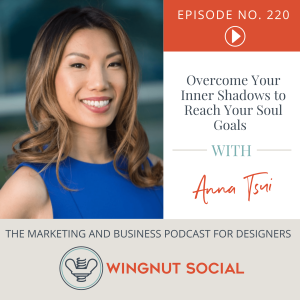
Wednesday Jun 09, 2021
Wednesday Jun 09, 2021
Business owners know what to do to get where they need to go. But every time they find success, they start thinking in circles and second-guessing themselves. Self-sabotage begins to kick in. Anna Tsui has noticed this with everyone she’s worked with. For Darla, self-sabotage translates into procrastination and self-doubt. So why do we people self-sabotage? What can you do to mitigate that voice in your head? In this episode of Wingnut Social, Anna talks about how to overcome self-sabotage and find your zone of genius.
Anna Tsui is a genius coach, international speaker, writer, and serial entrepreneur, and founder of the Intuitive Business School. She is also the best-selling author of “Shadow Magic: Turn Your Fear into Fuel and Create a Prosperous Coaching Business.”
What You’ll Hear On This Episode of Wingnut Social
[2:24] Mini News: Instagram like counts
[4:30] Learn more about Anna Tsui
[9:07] The interplay between your shadows and self-sabotage
[14:18] Pinpoint your soul’s goals
[16:43] The difference between self-sabotage and self-harm
[25:43] The most common shadow Anna sees in women
[27:31] How to overcome the shadows
[30:54] The zone of genius (get more at Wingnut Premium!)
[33:05] The “What Up Wingnut!” round
[34:12] How to connect with Anna
[37:28] Wingnut Blooper Reel!
Connect with Anna Tsui
Download half of Anna’s book for FREE: https://www.annatsui.com/book
Anna’s Website: https://www.annatsui.com/
The Intuitive Business School: https://www.annatsui.com/intuitive-business-school
Connect on LinkedIn: https://www.linkedin.com/in/annatsui/
Resources & People Mentioned
Book: How to Improve Your Marriage without Talking About It: https://www.amazon.com/Improve-Marriage-Without-Talking-About/dp/0767923189
The interplay between your shadows and self-sabotage
It all starts with your inner critic, or as Anna likes to call it, your shadows. Anna believes you inherit shadows from your family, culture, lineage, place of birth, religion, and more. The unconscious beliefs can come from your parents, religion, community, etc. Shadows also come from unconscious inner woundings where you don’t feel like you deserve something. These are the parts of you that are insecure and you don’t feel fully confident or loved. People are afraid of being visible and being seen for who they really are. Many people think if they are themselves, they’ll be judged. All of this comes from an unconscious part of you that’s just scared.
Anna believes you have to recognize that there is a magnetic message that only you can offer to the world. Your ideal clients want to experience the essence of who you are. It takes bravery. But when you want to show up in a certain way and something is holding you back, that’s part of your shadow. It’s part of your ego that keeps you in a safe container. It’s a great place to survive—but you won’t thrive or grow.
When is the universe telling you there’s a new direction to go?
Do you want that lifestyle that you envy so much in other people? Will you be working all the time? Is it something you really want, or is it your ego taking over?
Anna believes you should focus on your soul goals. What goals allow you to feel the way you want to feel? Anna points out that sometimes you really don’t know until you do it. You have to take the first steps to try it out. If you want to rebrand and try a different persona, do it. If it works for you, great! If it doesn’t, then you know. Don’t let your shadows hold you back.
Anna points out that when Darla is talking about Wingnut Social (versus her interior design business), her energy is completely different. The energy of what you love feels so different. Money and success can come in the way of doing what you love. But fear, guilt, and doubt say “You can’t do that.”
“When you feel into the fears and when it stops you, that’s when you know.”
How to overcome your shadows
People don’t realize how much fear is running their business. If you’re surrounding yourself with “I can’t do this because…” then it’s time to take a breath and realize your fear is running the show.
Sometimes if you take a few small steps, you’ll start feeling charged because what you’re doing gives you energy. If you show up with confidence, people perceive you differently. It’s really important to have a coach that can reassure you and lend you their energy when you’re tapped dry.
Anna also recommends that you carve out and own that you are important and your self-care is important as a factor that helps your business thrive. Anna also loves the concept of connecting with your inner saboteur. If you ask “What’s going on?” you’ll find you’ll get a response. It’s all about building awareness. You have to build a relationship with these parts of yourself. The deeper the relationship, the more you can get into the juiciness of the human experience.
Anna has developed a process to help people connect to their zone of genius (and connect to their genius flow). Want to learn more? Check out the premium episodes of Wingnut Social!
Connect With Darla & Wingnut Social
www.WingnutSocial.com
On Facebook
On Twitter: @WingnutSocial
On Instagram: @WingnutSocial
Darla’s Interior Design Website
Check out the Wingnut Social Media Lab Facebook Group!
1-877-WINGNUT (connect with us for your social media marketing needs)
Wingnut Social Podcast Sponsor
Desi Creswell’s Daily Planner
Subscribe to The Wingnut Social Podcast on iTunes, Google Podcasts, or TuneIn
Audio Production and Show notes byPODCAST FAST TRACKhttps://www.podcastfasttrack.com
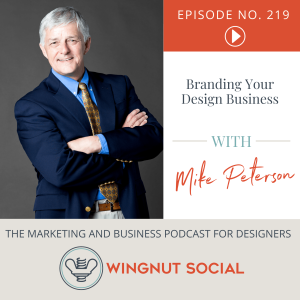
Wednesday Jun 02, 2021
Wednesday Jun 02, 2021
What is the easiest way to brand your design business? How do you stand out from the crowd enough to land clients? Mike Peterson has spent most of his career in the world of publishing with magazines like Country Living, House Beautiful, and Luxe. He loves all things marketing, branding, and interior design. He has the unique experience to help interior designers set themselves up for success with the right branding for who they are. Listen to this episode of Wingnut Social for his strategies!
What You’ll Hear On This Episode of Wingnut Social
[1:43] Wingnut Premium members only!
[4:21] Mini News Sesh: Instagram Lives
[6:13] Introducing Mike Peterson
[9:42] What is a brand?
[13:22] How to differentiate yourself
[18:08] Your name or a brand name?
[26:02] Is there value in magazine marketing?
[29:49] How to showcase your brand the right way
[32:03] The What Up Wingnut! Round
[36:37] Blooper Reel!
Connect with Mike Peterson
LinkedIn
Visionary Design Marketing
Mike(at)VisionaryDM.com
Resources & People Mentioned
Wingnut Social Episode #122
BOOK: Beauty, Neuroscience, and Architecture
You are your brand—not just a commodity
We are surrounded by brands. They’re prevalent in our lives. Starbucks. Armani. Grey Goose. BMW. Fuji. Mike emphasizes that “If the world can find a way to brand water, think about what we can do with all of the talent listening to this podcast right now.” What is it like to not have a brand in a world of brands?
A lot of people overthink their brand. A brand is not what you do, it is a relationship. Who is your best friend? Why is that person your best friend? You’re likely using subjective and emotional words based on relatability. The most important people are important because of emotional relationships. That is the foundation of brand marketing.
Identify the value and the personality characteristics of who you are—not what you do. Mike believes that “A lot of designers design. But every designer has a unique personality of their own. You will attract people of like mind as a result.”
How can Mike and his team help you differentiate yourself in the marketplace? Listen to hear their genius process for narrowing down your brand!
How to differentiate yourself
Mike shares that you can’t be afraid to ask for help. Business management and marketing aren’t taught in design schools. Mike has a three-phase process with his clients. They talk with a designer about their brand and their personality. But they go out and talk to 12–15 of the designer’s clients (whether by Zoom or in-person). One of the questions they ask is, “How do you feel as a result of what the designer did for you?” That question provides gold nuggets to understand what the designer has done. They get responses like:
“I felt heard”
“She fought for us.”
“I’m at peace.”
Your marketplace and audience become the foundation for your marketing process. The website begins to write itself. Don’t just depend on what you think your brand is. Reach out and ask your client or get a third party involved.
Does the service you provide take a backseat? Is there value in magazine marketing? Listen as Mike shares how to showcase your brand the right way.
Want to learn about geotargeting? Listen to the extended interview by signing up for Wingnut Premium!
Connect With Darla & Wingnut Social
www.WingnutSocial.com
Wingnut Premium
On Facebook
On Twitter: @WingnutSocial
On Instagram: @WingnutSocial
Darla’s Interior Design Website
Check out the Wingnut Social Media Lab Facebook Group!
1-877-WINGNUT (connect with us for your social media marketing needs)
Wingnut Social Podcast Sponsor
Desi Creswell’s Daily Planner
Subscribe to The Wingnut Social Podcast on iTunes, Google Podcasts, or TuneIn
Audio Production and Show notes byPODCAST FAST TRACKhttps://www.podcastfasttrack.com



